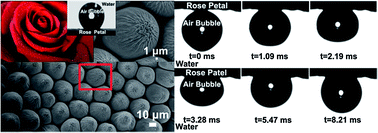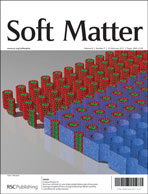Many well-known natural superhydrophobic surfaces exhibit unique characteristics when immersed in the aqueous medium. In the present paper, the phenomenon of the steady pinning effect of air bubbles on a rose petal with a combination of hierarchical rough structures (i.e., micropapillae and nanofolds) is described. The pinning force of a 2 μL air bubble is ca. 101.2 μN, and the critical flow velocity of water leading the three-phase contact line (TPCL) to slide is as quick as 124.7 mm s−1. The artificial rose petal surface was prepared from polydimethlsiloxane (PDMS) by a casting technique. It has the same nanofolds and micropapillae as the rose petal surface, and shows a similar air bubble pinning effect. The pinning force and the critical flow velocity of the artificial rose petal surface are 140.7 μN and 156.7 mm s−1, respectively. Smooth and rough PDMS films with an ordered nanostructure or patterned microstructure are utilized to study the contribution of the micro/nano hierarchical structures to the air bubble pinning effect. Particularly, the facility that the captured air pockets in the nanostructure of the rose petals (ca. 500–600 nm in width on each micropapilla tip) coalesce with the air bubble is shown. The process where a periodic array of microstructures (diameter: 16 μm, height: 7 μm) construct “absorbed” islands to avoid the coalescence between the adjacent air pockets on the nanofolds is demonstrated as well. The important roles of the size and distribution of the microstructure of the rose petal in the air bubble pinning process are highlighted. This steady pinning effect induced on superhydrophobic surfaces with micro/nano hierarchical rough structures should spark further theoretical study on other bubble-related interfacial phenomena and should open a new avenue for their application in industrial processes, including the cleaning of boats contaminated by plankton and oil, reduction of drag friction on ships and submarine hulls, and the foaming control process.

You have access to this article
 Please wait while we load your content...
Something went wrong. Try again?
Please wait while we load your content...
Something went wrong. Try again?


 Please wait while we load your content...
Please wait while we load your content...